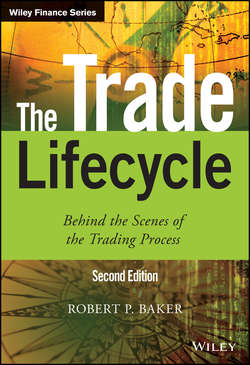Читать книгу The Trade Lifecycle - Baker Robert P. - Страница 5
На сайте Литреса книга снята с продажи.
Foreword from the First Edition
ОглавлениеTrading has evolved from a humble apple grower wanting a stable price for his produce come harvest time, to a complex and exciting industry comprising a significant share of the global economy.
Trading is the fundamental activity of investment banks, hedge funds, pension funds and many other financial companies. There is no better way to understand the workings of a financial entity than to follow the progress of a trade through its lifecycle and all the activities performed upon it.
This book will dissect a trade into its components, track it from conception to maturity and describe the raison d'etre of the business functions of a financial entity all arising from the processing of a trade. Having seen the full path of a trade, the reader will gain a more complete view of the world of finance which will answer some fundamental questions such as why, what and how people trade.
Derivatives are complex variations of standard trades. By contrast and comparison with the lifecycle of standard trades the reader will glean a better understanding of these often misunderstood financial instruments.
Together with the trade itself, the book will explore essential activities such as booking, confirmation, settlement, risk management, legal obligations, finance and control functions such as credit, market risk and auditing. Almost every person working in an investment bank or hedge fund has a large part of their work connected to the lifecycle of a trade. It is the glue by which all the departments are bound and the aggregated success or failure of each trade determines the survival and growth of the entire organisation.
The book also draws on real life experience of the trading floor. The sights and sounds of the action are brought to life to allow the reader to see how abstract concepts are actually practised. Detailed case studies illustrate how financial business problems were solved with varying degrees of success. There is also a unique description of the world of the quantitative analyst – a function that few people understand.
Why this book?
Many volumes have been written on the business side of trading and related activities such as market risk management. Although particular areas of the processes behind trading have been explained, I have not found the complete lifecycle of a trade fully described in one book. I feel a thorough end-to-end guide would be of interest to:
■ anyone seeking work in the financial services industry
■ people already in the industry who want to see how their work fits into the organisation as a whole
■ those with an interest in the activities of a financial entity. They could include clients, academics, pension holders and people making investments of all sizes
■ people selling products and services to the financial sector such as software vendors.
The importance of the financial sector to the world economy has been brought into focus by many recent events: the credit crunch, the collapse of companies such as Lehman Brothers and a recession affecting most countries across the world. The result has been a demand for better inspection and regulation of trading activities. No longer is it sufficient for firms to return profits, they have to convince investors, shareholders and regulators that they are employing due diligence and managing risks.
In writing about the trading process, my aim is to reveal all areas subject to potential risk. Once a risk is known, it can be monitored and managed even if the eventual decision is not to take action – forewarned is forearmed.
Although any financial entity engaged in trading activities will have already arrived at a set of processes spanning the trade lifecycle, these are not always performed in an optimal fashion; they may have evolved more by historical accident than by design. A careful reappraisal of the entire trading processes can lead to:
■ a reduction in risks
■ exposure of weaknesses
■ lower operating costs
■ elimination of wastage
■ better overall awareness leading to more confidence in the trading process.
I hope that this book might encourage all participants in the trade lifecycle to look again at their activities and those of their colleagues and see where improvements can be made to reduce risk and enhance the reputation of a battered industry.
Gaining employment in the financial sector is becoming increasingly competitive. It is no longer sufficient to have the skills and experience in one business function. Applicants must demonstrate an understanding of where they fit into the organisation and have the ability to communicate with other business functions – every activity in the trade lifecycle being connected to others. This book is written with a view to helping this understanding.
I have tried to make the book a readable progression through all the important activities and components of the trade lifecycle. Detailed explanations are given where necessary, but the book is intended as a comprehensive overview and therefore I have avoided too much detail where it might hinder the reader's ability to see the full picture.
Any mistakes are mine. All views expressed are entirely my own.
